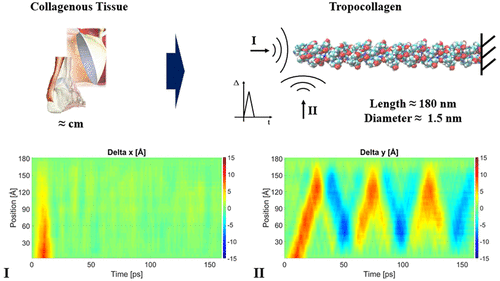当前位置:
X-MOL 学术
›
ACS Biomater. Sci. Eng.
›
论文详情
Our official English website, www.x-mol.net, welcomes your feedback! (Note: you will need to create a separate account there.)
Wave Propagation and Energy Dissipation in Collagen Molecules
ACS Biomaterials Science & Engineering ( IF 5.8 ) Pub Date : 2020-02-04 , DOI: 10.1021/acsbiomaterials.9b01742 Mario Milazzo 1, 2 , Gang Seob Jung 1 , Serena Danti 1, 2, 3 , Markus J. Buehler 1
ACS Biomaterials Science & Engineering ( IF 5.8 ) Pub Date : 2020-02-04 , DOI: 10.1021/acsbiomaterials.9b01742 Mario Milazzo 1, 2 , Gang Seob Jung 1 , Serena Danti 1, 2, 3 , Markus J. Buehler 1
Affiliation

|
Collagen is the key protein of connective tissue (i.e., skin, tendons and ligaments, and cartilage, among others), accounting for 25–35% of the whole-body protein content and conferring mechanical stability. This protein is also a fundamental building block of bone because of its excellent mechanical properties together with carbonated hydroxyapatite minerals. Although the mechanical resilience and viscoelasticity have been studied both in vitro and in vivo from the molecular to tissue level, wave propagation properties and energy dissipation have not yet been deeply explored, in spite of being crucial to understanding the vibration dynamics of collagenous structures (e.g., eardrum, cochlear membranes) upon impulsive loads. By using a bottom-up atomistic modeling approach, here we study a collagen peptide under two distinct impulsive displacement loads, including longitudinal and transversal inputs. Using a one-dimensional string model as a model system, we investigate the roles of hydration and load direction on wave propagation along the collagen peptide and the related energy dissipation. We find that wave transmission and energy-dissipation strongly depend on the loading direction. Also, the hydrated collagen peptide can dissipate five times more energy than dehydrated one. Our work suggests a distinct role of collagen in term of wave transmission of different tissues such as tendon and eardrum. This study can step toward understanding the mechanical behavior of collagen upon transient loads, impact loading and fatigue, and designing biomimetic and bioinspired materials to replace specific native tissues such as the tympanic membrane.
中文翻译:

胶原分子中的波传播和能量耗散
胶原蛋白是结缔组织(例如,皮肤,腱,韧带和软骨等)的关键蛋白,占全身蛋白含量的25–35%,并赋予机械稳定性。这种蛋白质也是骨骼的基本组成部分,因为它具有出色的机械性能以及碳酸羟基磷灰石矿物质。尽管从分子水平到组织水平都已在体外和体内研究了机械弹性和粘弹性,但尽管对于理解胶原结构的振动动力学至关重要(例如, ,耳膜,耳膜)。通过使用自下而上的原子建模方法,在这里,我们研究两种不同的脉冲位移载荷下的胶原蛋白肽,包括纵向和横向输入。使用一维字符串模型作为模型系统,我们研究了水合作用和载荷方向在沿胶原肽传播的波及相关能量消散中的作用。我们发现波的传播和能量耗散在很大程度上取决于载荷的方向。此外,水合胶原蛋白肽的能量消耗比脱水胶原蛋白肽多五倍。我们的工作表明,胶原在不同组织(如肌腱和鼓膜)的波传播方面具有独特的作用。这项研究可以逐步了解胶原蛋白在瞬时载荷,冲击载荷和疲劳时的机械行为,
更新日期:2020-02-04
中文翻译:

胶原分子中的波传播和能量耗散
胶原蛋白是结缔组织(例如,皮肤,腱,韧带和软骨等)的关键蛋白,占全身蛋白含量的25–35%,并赋予机械稳定性。这种蛋白质也是骨骼的基本组成部分,因为它具有出色的机械性能以及碳酸羟基磷灰石矿物质。尽管从分子水平到组织水平都已在体外和体内研究了机械弹性和粘弹性,但尽管对于理解胶原结构的振动动力学至关重要(例如, ,耳膜,耳膜)。通过使用自下而上的原子建模方法,在这里,我们研究两种不同的脉冲位移载荷下的胶原蛋白肽,包括纵向和横向输入。使用一维字符串模型作为模型系统,我们研究了水合作用和载荷方向在沿胶原肽传播的波及相关能量消散中的作用。我们发现波的传播和能量耗散在很大程度上取决于载荷的方向。此外,水合胶原蛋白肽的能量消耗比脱水胶原蛋白肽多五倍。我们的工作表明,胶原在不同组织(如肌腱和鼓膜)的波传播方面具有独特的作用。这项研究可以逐步了解胶原蛋白在瞬时载荷,冲击载荷和疲劳时的机械行为,

























 京公网安备 11010802027423号
京公网安备 11010802027423号